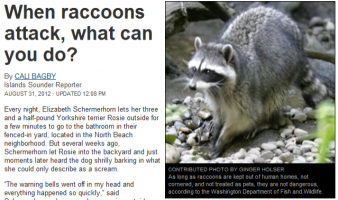 Calling all raccoon removal services like GTA’s Skedaddle Wildlife: Toronto Sun’s Ted Woloshyn reported in one of his columns that with an average of 50 raccoons per square kilometre, Toronto is undoubtedly the Raccoon Capital of the World. Originally from the tropics and sub-tropics, raccoons have increasingly moved into urban areas of North America, Europe and even Japan, leading to a corresponding surge in the number of hostile encounters between humans and raccoons.
Calling all raccoon removal services like GTA’s Skedaddle Wildlife: Toronto Sun’s Ted Woloshyn reported in one of his columns that with an average of 50 raccoons per square kilometre, Toronto is undoubtedly the Raccoon Capital of the World. Originally from the tropics and sub-tropics, raccoons have increasingly moved into urban areas of North America, Europe and even Japan, leading to a corresponding surge in the number of hostile encounters between humans and raccoons.
The raccoon problem is more prominent in big cities such as Toronto. In Chicago, for example, the lakefront area is swarming with raccoons. According to the most recent available statistical data from Illinois Department of Natural Resources (IDNR), in 2009 as many as 17,000 raccoons have been trapped and euthanized in Cook County, where Chicago is a component city.
Close to the border of the Canadian province of British Columbia, the North Beach neighborhood of Orcas Island of the U.S. state of Washington is starting to come to grips with the gravity of raccoon infestations. “I couldn’t scare them away. It was so scary, I’ve never seen so many before,” says Patricia Tullock, whose cat was attacked by six raccoons. A week prior to her cat’s attack, a Yorkshire terrier owned by her neighbor, Elizabeth Schermerhorn was bitten by a large raccoon.
Given the numerous wild critters that residents of the Greater Toronto Area deal with, it’s not surprising that raccoon removal in Toronto has developed into an industry that has set many of the existing standards. Raccoons living off the city’s garbage have also spurred the growth of the pest control market in Seattle, WA. On the other hand, archipelagic San Juan County, located on the northern fringe of the state, which Orcas Island is a part of, has no animal control sector. Thus, reports concerning raccoons are handled by the Sherrif’s Office, who in turn asks the Washington Department of Fish and Wildlife (WDFW) for assistance in trapping and relocating the masked bandits.
“If you remove raccoons, it creates an open space and other raccoons will move in,” says Shona Aitken, education coordinator at Wolf Hollow Wildlife Rehabilitation Center. According to an official statement, they believe that raccoons do not pose a threat to humans as long as they are “kept out of human homes, not cornered, and not treated as pets.”
Aitken believes that cities develop raccoon problems when residents feed these engaging creatures, and they become too familiar. The people who feed raccoons usually stop giving them handouts when the animals get bigger and destructive; with the resulting shut-out causing the raccoons to become even more desperate for food.
Raccoons are rather clever and entertaining creatures which don’t always cause serious damage. Sometimes, they come up with the funniest antics. This February, a couple of raccoons halted construction of a 304-unit apartment complex by claiming a tower crane’s cab as their home.
Other Sources:
http://www.torontosun.com/comment/columnists/ted_woloshyn/2011/02/03/17144261.html
http://www.suntimes.com/news/metro/5098889-418/raccoon-infestation-hits-the-lakefront.html
http://www.huffingtonpost.com/2013/02/07/raccoons-make-home-atop-w_0_n_2637691.html


